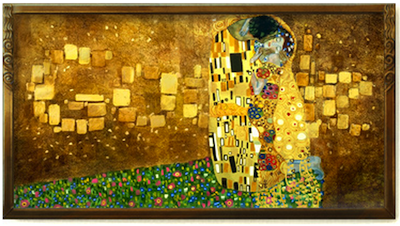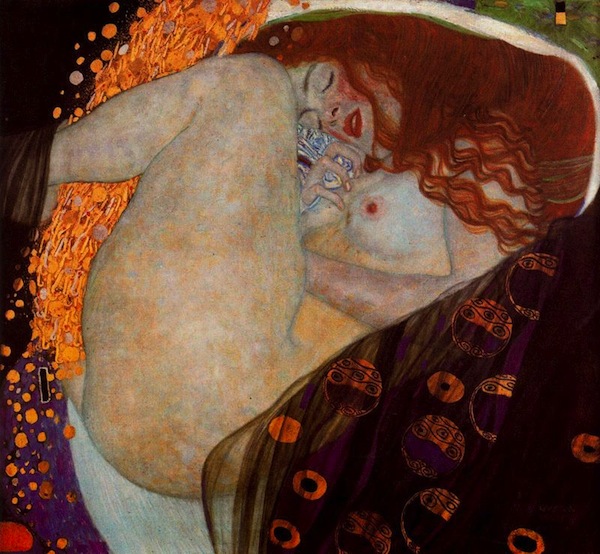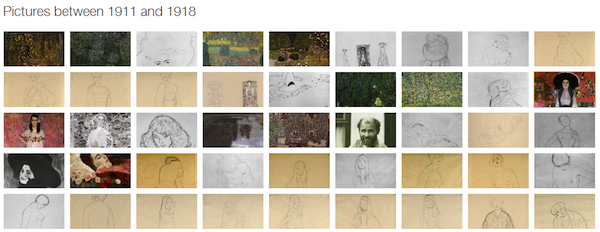
The work of once controversial and now revered Austrian symbolist painter Gustav Klimt are celebrated on Google’s homepage today, in honor of his 150th birthday. Born in 1862 near Vienna, in Baumgarten, Klimt reveled in human sexuality and eventually led the Secession movement in Austria. His use of eroticism and provoking sexual imagery challenged the safe, predictable tradition of Austrian art.
Today, Klimt’s most famous work, The Kiss, overlays the Google logo on the homepage. A masterful piece of oil and goldleaf on canvas, The Kiss features a couple experts believe to be the artist himself and longtime love Emilie Flöge, in a passionate embrace. Clicking on the image leads to a search results page for Gustav Klimt.
Interestingly, the original painting is square; Google has built the image out to a rectangular shape, carrying the lines of the grass and flowers, as well as the background, onto a secondary “canvas.” This is where the Google logo appears, with part of the second “o” and the entire second “g” in Google obscured by an image now considered tame, though it was wildly provocative at the time. The entire piece is held within a mock wooden frame.
Raised in poverty alongside his six brothers and sisters, Gustav was one of three sons with noticeable artistic talent. In 1876, he was awarded a scholarship to Kunstgewerbeschule, the Vienna School of Arts and Crafts, where he would study architectural painting alongside his brother Ernst, who enrolled in 1877.
Born the son of an immigrant goldsmith, Klimt was skilled in engraving and also graced with coming of age in the cultural flowering of Vienna, then the fourth-largest city in all of Europe. It was the ideal environment in which to experiment, push the limits, and hone his craft.

Students Gustav and Ernst Klimt, with protege Franz Matsch, launched a team called the Company of Artists, first assisting their teacher paint murals in Vienna’s Kunsthistorisches Museum, then accepting commissioned works as a group. Early in his career as a professional painter, Klimt’s greatest bodies of work were murals and ceiling artscapes in the large public buildings on the Ringstrasse, the circular road around Vienna’s Innere Stadt district.
Even in earlier pieces, Klimt never seemed a novice. In the period spanning 1886-1888, he worked on the Burgtheater alongside his team, tasked with creating scenes from the theater’s history on stairway ceilings and the tympanum. In his early twenties at the time, he showcased superior technical skills and a passion for near-photographic portrait work, such as in The Theater in Taormina. On completion of his work in the Burgtheater, Klimt was awarded the Golden Order of Merit by Austrian Emperor Franz Joseph I.
Personal circumstance, driven by love and tragedy, worked to shape his unique perspective and artistic evolution in his thirties and forties.

Klimt met Emilie Flöge when she was 18. In 1891, his brother Ernst had married Flöge’s younger sister, Helene. The following year, both his father and brother Ernst died, requiring that Klimt, at thirty years old, take over financially supporting both families. He was made Helene’s legal guardian and became familiar with Emilie through much time spent with the family.
Flöge would eventually become a noted couturière in her own right. She and Klimt hung with Vienna’s trendy Bohemian and fin de siècle crowd; that members of Vienna’s elite upper crust were often the subject of Klimt’s portraits opened doors for Flöge, as an haute couture designer.
They would never marry, though she remained his partner the rest of his life. In 1902, Klimt painted a portrait of Flöge, fully dressed; it was just one of the works reportedly inspired by his companion.

Avenue in the Park of Schloss Kammer, 1912
Klimt completed The Kiss, displayed on the Google homepage today, in 1908. It was one of his many sensual portrayals of women and an example of the oil and gold leaf on canvas technique used in a number of his works. It is also believed to be a self-portrait, featuring Klimt and Flöge themselves as lovers.
Though many consider Klimt one of the most influential artists of his time, author and journalist Dr. Frank Whitford famously panned that notion when speaking on BBC TV documentary, The Kiss: Private Life of a Masterpiece. “Klimt of course, is an important artist – he’s a very popular artist – but in terms of the history of art, he’s a very unimportant artist,” said Whitford. “Although he sums up so much in his work, about the society in which he found himself – in art historical terms, his effect was negligible. So he’s an artist, really, in a cul-de-sac.”
Klimt’s work is considered to have evolved greatly during and just after his work on The Kiss; even in 1908, as The Kiss came out, his art took on a more blatantly sexual, erotic tone, as in Danae.

Says A World History of Art’s description of Danae (circa 1907-1908):
After The Kiss, Klimt became less willing to conceal: this is the ecstasy of love, at the very moment when the shower of gold pieces mingled with gilded spermatozoa – the form in which Zeus chooses to ‘visit’ the sleeping heroine, symbol of carnal and sensual beauty – pours down between her gigantic thighs.”
It may be more accurate to say society, rather than Klimt, had evolved by the time he released Danae. Klimt had earlier been forced to remove from the first Secession movement exhibition a painting that pushed the boundaries too far for 1903 Vienna.
Hope I, an oil on canvas nude portrait of a pregnant woman with her pubic hair on display, was considered far too controversial at the time. In 1970, Hope I was acquired by the National Gallery of Canada, where it now resides.
Of Hope I, the gallery writes, “In this richly symbolic painting, Klimt juxtaposes the promise of new life with the destructive forces of death. Despite the monstrosities around her, the pregnant woman remains calm and unperturbed, confident of the renewal within her. In preliminary sketches for this painting the tone is more positive: the sketches show a couple within a landscape reflecting upon their happiness. Klimt’s decision to change the composition may have stemmed from his reaction to the death of his second son during infancy in 1902.”
Throughout his career, Klimt’s greatest subject was the female body, whether in oil paintings, sketches, murals, or other art pieces.

Images on display on the Klimt Museum website
From 1908 to 1914, Klimt himself supervised the publication of Das Werk Gustav Klimts, the only folio set produced in his lifetime. Emporer Franz Joseph I was first to purchase Das Werk Gustav Klimts, consisting of fifty images depicting his most important paintings, reproduced using collotype lithography. Fünfundzwanzig Handzeichnungen and Gustav Klimt An Aftermath were released posthumously, in 1919 and 1931, respectively.
Klimt is often historically associated with his Austrian contemporary Sigmund Freud, who also worked diligently in that era to publicly push sexual boundaries. The artist of The Kiss is also believed to have fathered 14 to 17 illegitimate children before his death by stroke, during the 1918 Spanish Flu pandemic. Many of the women with whom he had affairs are believed to have been featured in his portraits.
His most ambitious work, the Beethoven Frieze, is on permanent display in the Vienna Secession Building, where a sex club was fittingly invited to hold orgies alongside Klimt’s sexually charged work in 2010.

Considering some of Klimt’s more erotic pieces, it seems as though Google played it safe by featuring one of the tamer, yet more popular, of his paintings, in celebration of a man who loved to see how far he could push the sensibilities of modern society.
Google has featured the works of other artists in Google doodles on the homepage recently, including:
Biographical information courtesy of The Klimt Museum and Gustav-Klimt.com.






